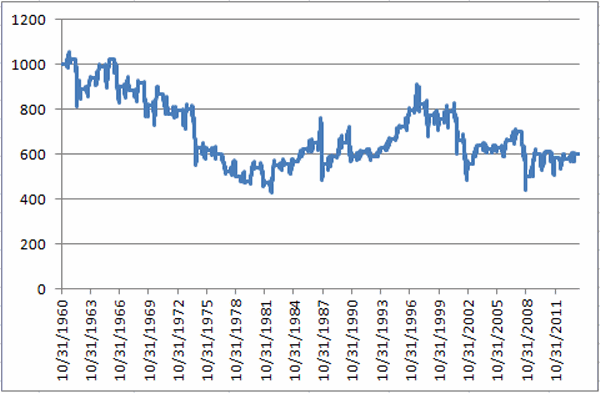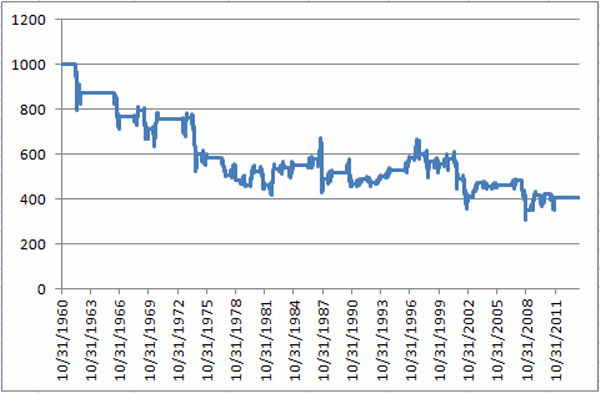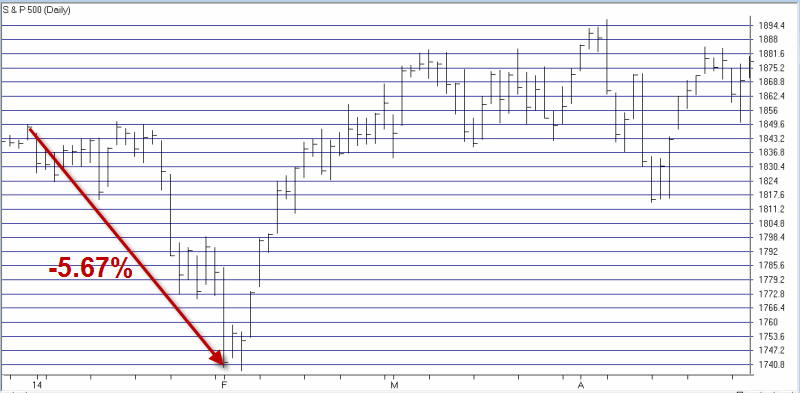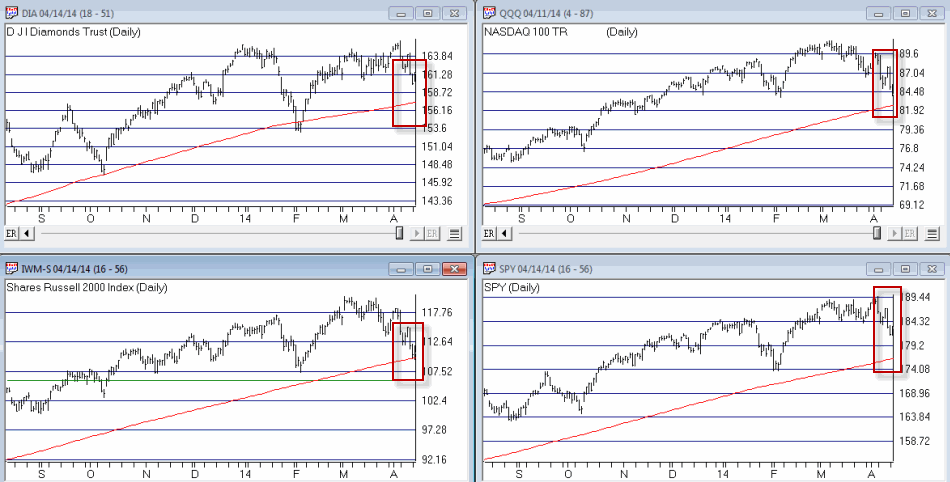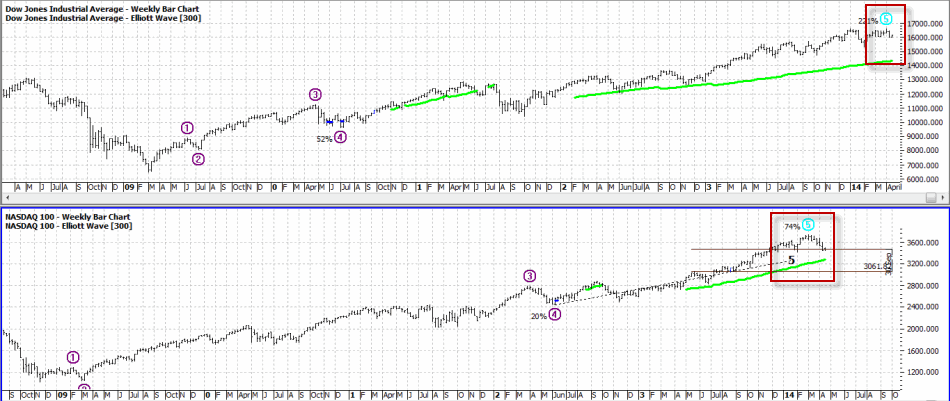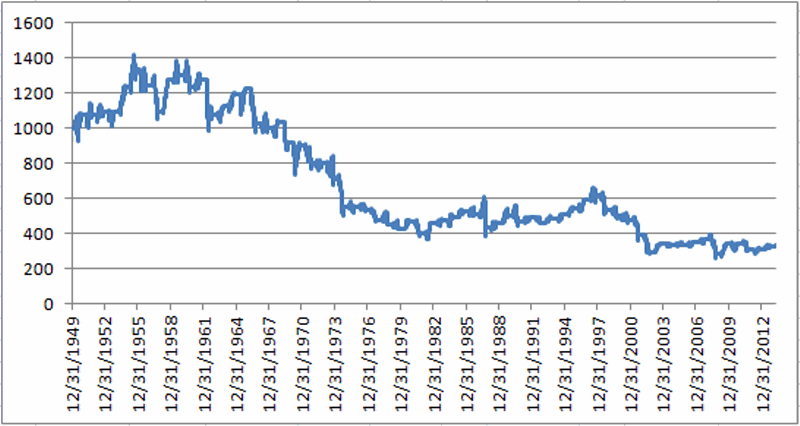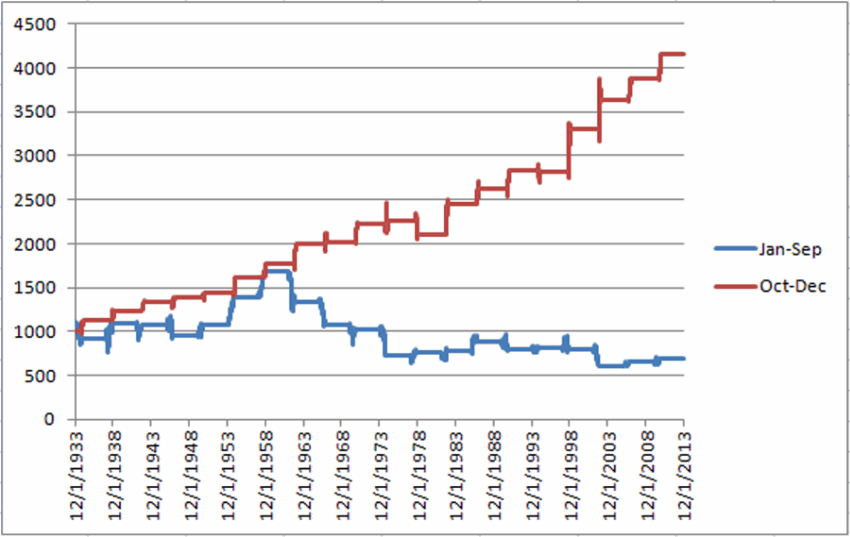Jun 5, 2014 | bonds, trading strategies
Watching Weekly Dow Momentum
The stock market – like the Energizer Bunny – just keeps chugging along, with the Dow, the S&P 500 and the Nasdaq 100 all touching new highs in the last week (the Russell 2000 small-cap index is another story, and may ultimately serve as the “canary in the coal mine”, but for now “majority rules”). So for now, disciplined trend-followers (“Hi my name is Jay – although it is a little difficult to speak at the moment as my teeth remain tightly clenched”) have done well to avoid all of the “Sell in May” warnings from all of those so called experts (“Um, hi my name is Jay?”). But there is one sign that I think investors should follow that has historically proven useful during the middle months of mid-term election years.
I first wrote about this on 5/6/2014 in an article titled “A Warning Sign to Watch“. For full details I suggest you read that article, but for now let me give you the gist.
-Between May and October of mid-term election years, a warning sign occurs when the MACD Oscillator (many traders refer to it as the MACD Histogram) drops into negative territory.
Figure 1 – Weekly Dow Industrials with MACD Oscillator (watch for drop to negative territory) courtesy AIQ TradingExpert
For the record, the MACD Oscillator was below 0 during early May, but was in a rising trend along with the Dow itself. The Oscillator returned to positive territory on 5/23 and remains there still. So let me sum up my advice as succinctly as possible:
*KEEP AN EYE ON THE WEEKLY MACD OSCILLATOR FOR THE DOW JONES INDUSTRIALS AVERAGE.
If it drops into negative territory be prepared to take defensive action.
If you have even the most basic charting software, checking the status of the weekly Dow MACD Oscillator after the close each week will take up approximately 12 seconds of your time. Per the 5/6/14 article, if history is any guide, the 12 seconds a week time investment may prove to be very useful.
Looking for a Reversal in T-Bonds
As I write, t-bonds are in the middle of a nasty short-term sell off. But there is hope. As I wrote about on 4/8/14 in an article titled “A Simple Signal for Bond Traders”, a short-term bullish setup may be forming at the moment. In a nutshell:
*When the 25-day moving average for ticker EWJ is below the 150-day moving average for ticker EWJ (long story short, t-bonds tend to trade inversely to Japanese stocks – go figure), then
*Wait for the 10-day CCI (Commodity Channel Index) for ticker TLT to drop below -100 and then turn up for one day.
Once that occurs a trader might consider buying the call option with at least 40 days left until expiration and the highest gamma among call options for that expiration.
In Figure 2 you can see that this setup is presently “locked and loaded” and will be triggered when the 10-day CCI for ticker TLT reverses back to the upside.
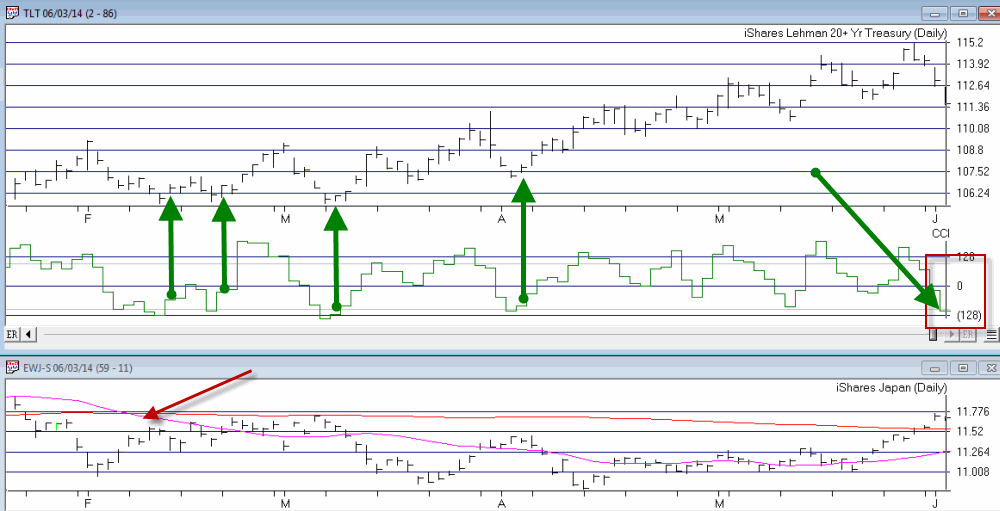
Figure 2 – TLT forming a potentially bullish setup courtesy AIQ TradingExpert Pro
Traders should always remember that there is never any guarantee that the next signal will generate a profit, and should always have some sort of stop-loss or risk limiting planin place at the time that any new trade is entered.
Jay Kaeppel
Chief Market Analyst at JayOnTheMarkets.com and AIQ TradingExpert Pro (http://www.aiq.com) client
Jay has published four books on futures, option and stock trading. He was Head Trader for a CTA from 1995 through 2003. As a computer programmer, he co-developed trading software that was voted “Best Option Trading System” six consecutive years by readers of Technical Analysis of Stocks and Commodities magazine. A featured speaker and instructor at live and on-line trading seminars, he has authored over 30 articles in Technical Analysis of Stocks and Commodities magazine, Active Trader magazine, Futures & Options magazine and on-line at www.Investopedia.com.
May 30, 2014 | color studies, EDS code, Stocks & Commodities Traders Tips, trading strategies
The AIQ code and EDS file based on Donald W. Pendergast’s article in the 2014 Bonus Issue of
Stocks & Commodities, “A Trading Method For The Long Haul,” can be found at http://
TradersEdgeSystems.com/traderstips.htm.
The code I provide there for the long haul system is modified somewhat from the author’s descriptions as follows. First, I did not implement the fundamental rule, but this can be done if a data source is located that can export the fundamental fields needed for each stock into a .csv file. This could then be imported into the fundamental module. Second, I modified the exit to add an RSI profit target and changed some of the exit parameters.
To get the code to run properly, the AIQALL list of stocks and groups must be installed and updated on the user’s computer. To do this, first get the most recent AIQALL list from the AIQ website, then add all the stocks from the latest data disk that have trading volume greater than about 200,000 shares. We need these in order to have enough stocks to compute the group indexes. Next, we would download data for all the stocks in the database up to the current date. Then, as shown in Figure 6, we would set the RS tickers to the AIQALL list, and also, as shown in Figure 7, recompute all dates for all the groups in the AIQALL list.
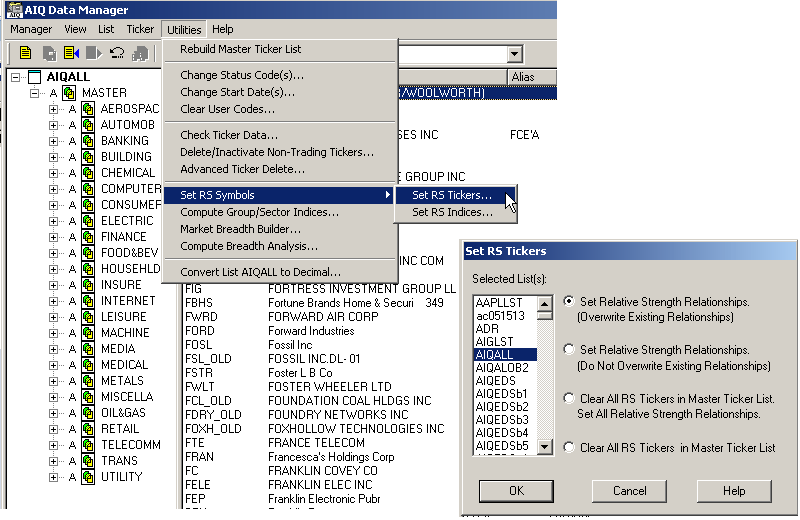
FIGURE 6: AIQ DATA MANAGER. Use the AIQ Data Manager to set the RS tickers to the AIQALL list.
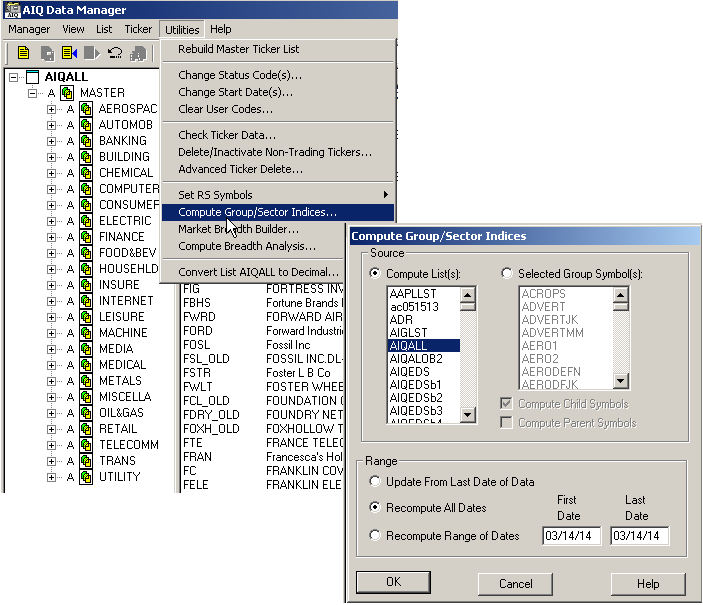
FIGURE 7: AIQ DATA MANAGER. Use the AIQ Data Manager to compute the group & sector indexes for the AIQALL list.
The EDS file containing the code has the properties set to the AIQALL list. If you are building an EDS file directly from the code listing below, then be sure to set the properties to the AIQALL list.
!A Trading Method for the Long Haul
!Author: Donald W. Pendergast Jr., TASC Bonus Issue 2014
!Coded by: Richard Denning 3/10/14
!www.TradersEdgeSystems.com
!INPUTS:
trendLen is 200.
rsiLen is 2.
minAvgVolume is 10000.
volaLen is 21.
relStrLen is 80.
minVolaRatio is 0.5.
rsSPXmin is 1.0.
rsGroupmin is 1.0.
trailBars is 2.
rsiBuyLvl is 5.
rsiExitLvl is 95.
exitLen is 18.
C is [close].
H is [high].
L is [low].
PD is {position days}.
!LONG TERM MOVING AVERAGE:
emaLT is expavg(C,trendLen).
emaST is expavg(L,exitLen).
!RSI WILDER
!To convert Wilder Averaging to Exponential Averaging use this formula:
!ExponentialPeriods = 2 * WilderPeriod - 1.
U is C-valresult(C,1).
D is valresult(C,1)-C.
rsiLen1 is 2 * rsiLen - 1.
AvgU is ExpAvg(iff(U>0,U,0),rsiLen1).
AvgD is ExpAvg(iff(D>=0,D,0),rsiLen1).
rsi is 100-(100/(1+(AvgU/AvgD))).
!VOLATILITY
price1 is H.
price2 is L.
ratio is price1 / price2.
dp is Ln(ratio).
dpsqr is Ln(ratio) * Ln(ratio).
totdpsqr is sum(dpsqr,volaLen).
sumdp is sum(dp,volaLen).
sumdpsqr is sumdp * sumdp.
sumdpave is sumdpsqr / volaLen.
diff is totdpsqr - sumdpave.
!!use 252 for daily, or 52 for weekly below
factor is 252 / (volaLen-1).
result is sqrt(diff * factor).
vola is result * 100 .
volaAvg is expavg(vola,volaLen).
volaSPXavg is tickerUDF("SPX",volaAvg).
volaRatio is volaSPXavg/volaAvg.
!AVERAGE VOLUME
avgVolume is expavg([volume],50).
!RELATIVE STRENGTH
roc is C / valresult(C,relStrLen).
rocSPX is tickerUDF("SPX",roc).
rocGroup is tickerUDF(rsticker(),roc).
groupSymbol is tickerUDF(rsticker(),symbol()).
groupName is tickerUDF(rsticker(),description()).
rsSPX is roc / rocSPX.
rsGroup is rocGroup / rocSPX.
!SCREENING RULES
VolumeRule if avgVolume > minAvgVolume.
TrendRule if C > emaLT.
VolaRule if volaRatio > minVolaRatio and simpleavg(H-L,10) > simpleavg(H-L,200).
RelStrRule if rsSPX > rsSPXmin and rsGroup > rsGroupmin.
PullbackRule if rsi < rsiBuyLvl.
EnoughData if hasdatafor(trendLen+10) > trendLen.
!FundamentalRule if [eps]>[eps est].
Screen if EnoughData
and TrendRule
and VolaRule
and RelStrRule
and PullbackRule
!and FundamentalRule
and VolumeRule.
EntryTrigger if C > lowresult(H,2,1).
Buy if valrule(Screen,1) and EntryTrigger.
Exit if (C < lowresult(L,trailBars,1))
or
(valrule(C > emaST,1) and C < emaST)
or
rsi > rsiExitLvl.
ShowValues if EnoughData.
May 23, 2014 | ETFs, gold, trading strategies
Well, OK, maybe not. But life here in the Good Old US of A may be affected profoundly. Which of course, would ripple out and affect much of the rest of the world. So maybe it’s not that outrageous.
In any event, it sure is a catchy title, no? In truth this piece is not an immediate call to action, but rather one of those short “hey, you might want to keep your eye on this” type pieces. I am writing about the U.S. Dollar.
There are pro’s and con’s to a strong U.S. Dollar and there are pro’s and con’s to a weak U.S. Dollar. If you would like to know what they are please see the steps below:
Step 1) Go to your web browser. Type www.google.com and press Enter
Step 2) Type “pros and cons of strong U.S. dollar” and press Enter.
Step 3) Browse among the approximately 308,000 or so links until you find your answer.
Step 4) Type “pros and cons of weak U.S. dollar” and press Enter.
Step 5) Repeat Step 3.
Since at least the end of the gold standard in 1971 the U.S. dollar has served as the world’s “reserve currency”. (This basically means that if you could only hold one currency you would want to hold the dollar.) This has become one of those things that most people take for granted and assume will go on forever.
Still, given that we are now the most indebted “We the People” in the history of the planet, perhaps we shouldn’t be surprised that there has been a lot of talk recently (granted mostly among intentionally frightening and mostly annoying infomercials) about how the days of enjoying “reserve currency” status are numbered, and how this will trigger a panic out of the dollar, which will lead to all kind of bad things like, well, see Step 4 above.
Will the Dollar Collapse?
For me to pretend that I have the slightest idea whether or not the U.S. dollar will someday collapse would be a joke, and not the funny kind. But as a trader and investor my “thing” is not so much “what will happen” as it is “what could happen and what the heck do I plan to do about it if it does?”
Which leads me to the following distractions:
Jay’s Trading Maxim #235: It’s not so much how much you make when things go right, but how much you keep when thing goes wrong.
Jay’s Trading Maxim #236: If you take care of the losing trades, the winning trades will take care of themselves (OK, for the record, this is not mine, I just gave it number 236 so I could use it as a segue into…..)
Jay’s Trading Maxim #237: Successful traders worry less about “Kicked Ass” and more about “Ass Kicked”, if you get my drift.
So why am I bringing all of this up? Take a look at Figure 1 which displays a monthly chart of continuous U.S. dollar futures. While the history of U.S. dollar trends is all very interesting and I would love to recap it for you, I am going to opt for the “a picture is worth a thousand (likely incredibly boring) words” mantra and encourage you simply to glance at Figure 1 if you want to know where the dollar has been in the past.
And when you do – here is the important part – note that the dollar is forming a narrowing triangle (is there another kind?) pattern. In other words, starting with the high in 2006 the dollar has been fluctuating in an ever smaller range.
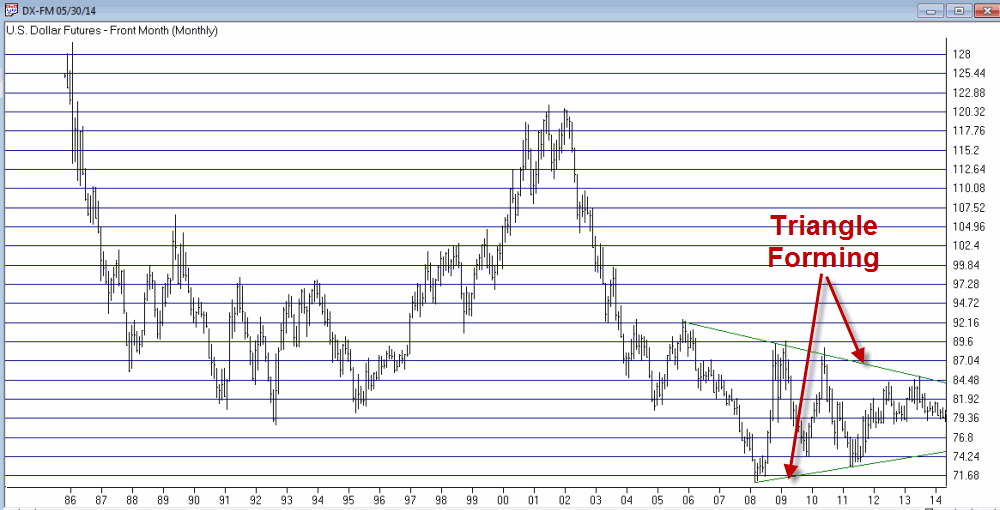
Figure 1 – A large triangle forming (Courtesy: AIQ TradingExpert)
We “market analyst types” refer to this as “coiling” action. Now if you are like me chances are you just squirmed slightly when you read that last sentence. Because we all know what happens when something stops coiling – that’s right, it “uncoils”. And “uncoiling” is typically not a quiet affair.
So here is the bottom line. At some point – and just for the record it might not be for several years – the U.S. dollar will break out of this triangle one way or the other. And chances are it will move sharply in price from that point. And whether it breaks out to the upside or the downside it will have significant implications for the quality of life here in the U.S. If you don’t believe me, see the 308,000 links referenced in Step #3 above.
So make a note to check in on the dollar once in awhile. Because one of these days something profoundly significant is going to happen.
Jay Kaeppel
Chief Market Analyst at JayOnTheMarkets.com and AIQ TradingExpert Pro (http://www.aiq.com) client
Jay has published four books on futures, option and stock trading. He was Head Trader for a CTA from 1995 through 2003. As a computer programmer, he co-developed trading software that was voted “Best Option Trading System” six consecutive years by readers of Technical Analysis of Stocks and Commodities magazine. A featured speaker and instructor at live and on-line trading seminars, he has authored over 30 articles in Technical Analysis of Stocks and Commodities magazine, Active Trader magazine, Futures & Options magazine and on-line at www.Investopedia.com.
May 15, 2014 | bonds, ETFs, group sector rotation, trading strategies
…and down will come, well just about everything, as far as I can tell.
OK, for the record maybe it should say “If the Dow Breaks.” After all I am still firmly ensconced here at “Camp Bull.” I would like to attribute this to disciplined nerves of steel, but it would be an understatement to say that that would be an overstatement. The truth is my crystal ball broke a very long time ago (sadly I continued believing what it portended for a long time before I realized it was actually broken). So I have long since held dual citizenship in “Camp Trend Follower”.
But I have got be honest…..I am feeling the urge to run like a sissy through the woods to “Camp Yikes”.
The Overall Market
Defining the “overall” market is something of a crapshoot these days, as some of the “overall” market seems to be going one way and another part of the “overall” market seems to be going another way. In Figure 1 we see the Dow, the S&P 500, the Nasdaq 100 and the Russell 2000.
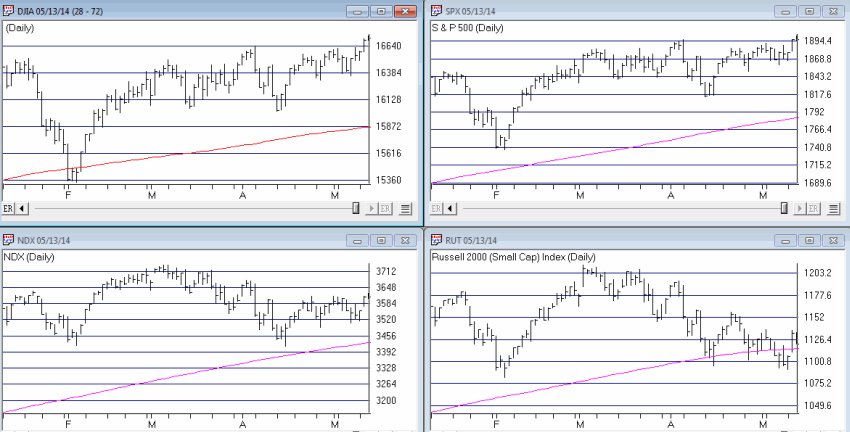
Figure 1 – The Four Major Averages with 200-day moving averages (charts courtesy AIQ TradingExpert Pro)
In a nutshell, the “Generals” are still marching but the “Troops” are in retreat. Now every market pundit seems to be offering up their opinion as to whether the “Generals” will ultimately lead the troops higher or the other way around. With my crystal ball still out of order I must unfortunately go with my stock answer here of “it beats the heck out me.” And “hey things are swell here at Camp Bull.” But I have been around this business long enough to remember several instance where the “Troops” led the way (1984, 1987, 1990, 2000, 2008) and the “Generals” followed. So we’ll see what we see.
OK, just in case that little segment was not foreboding enough, let’s get to the really “scary” part.
Sectors Suck in Summer (during Mid-term years)
One caveat before I even launch, the sample size of what I am about to detail is very small (6 calendar years each four years apart starting in 1990). Also, that’s the good news. As a “seasonalaholic” (“Hi, my name is Jay”) I am acutely aware of the following facts:
1. The market tends to perform better between the end of October and the third trading day of the following May than it does from the third trading day of May through the end of October (also known as “Where We Are Now.”)
2. This is a mid-term election year.
I also do a lot of work with sectors and sector funds as I have found that investing at the right sector at the right time is – all kidding aside – one heck of a great way to invest.
So I was curious as to which sectors tended to perform the best during the May to October period during mid-term election years. Here is the short list:
Health Care. Period.
Everything else. Well on a buy in May and sell in October basis – let’s just say it isn’t pretty. So here is the test I ran:
Tracking the growth of $1,000 invested in each Fidelity Select Sector fund only:
*Between the close of May trading day 3 and the end of September (for the record, October tends to be an OK month during mid-term election years – more on this topic in a future article) during each mid-term election year.
The results appear below in Figure 2. If you are squimish you might want to brace yourself.
|
Fund
|
%+(-)
|
|
FBIOX
|
(12.1)
|
|
FBMPX
|
(34.5)
|
|
FBSOX
|
(36.9)
|
|
FCYIX
|
(28.8)
|
|
FDCPX
|
(42.4)
|
|
FDFAX
|
(3.7)
|
|
FDLSX
|
(45.9)
|
|
FIDSX
|
(55.9)
|
|
FNARX
|
(35.4)
|
|
FPHAX
|
(18.6)
|
|
FSAGX
|
(1.6)
|
|
FSAIX
|
(65.7)
|
|
FSAVX
|
(71.4)
|
|
FSCGX
|
(58.9)
|
|
FSCHX
|
(49.7)
|
|
FSCPX
|
(31.2)
|
|
FSCSX
|
(35.9)
|
|
FSDAX
|
(62.7)
|
|
FSDCX
|
(38.2)
|
|
FSDPX
|
(57.5)
|
|
FSELX
|
(71.0)
|
|
FSENX
|
(42.9)
|
|
FSESX
|
(65.3)
|
|
FSHCX
|
(20.1)
|
|
FSHOX
|
(79.1)
|
|
FSLBX
|
(59.1)
|
|
FSLEX
|
(49.6)
|
|
FSMEX
|
(12.0)
|
|
FSNGX
|
(47.5)
|
|
FSPCX
|
(27.2)
|
|
FSPHX
|
41.6
|
|
FSPTX
|
(42.0)
|
|
FSRBX
|
(59.5)
|
|
FRESX
|
(26.4)
|
|
FSRFX
|
(61.2)
|
|
FSRPX
|
(43.8)
|
|
FSTCX
|
(35.4)
|
|
FSUTX
|
(12.1)
|
|
FSVLX
|
(59.1)
|
|
FWRLX
|
(32.8)
|
|
FNARX
|
(35.4)
|
Figure 2 – Net %+(-) invested only between 3rd trading day of May and last trading day of September during mid-term election years (1990 , 1994, 1998, 2002, 2006, 2010, 2014)
Anyone notice a trend? To see just how bad things can be, once you are able to work yourself back up out of the fetus position, take a glance at Figure 3, which shows the three worst performers during the May-Sep mid-term year period – FSAIX (-71%), FSELX (-71%) and FSHOX (-79%).
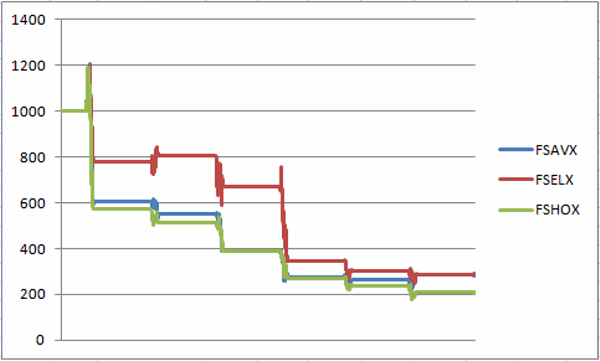
Figure 3 – FSAIX, FSELX, FSHOX – growth of $1,000 May through Sep of mid-term election years (1988-present)
Now I have an obvious flare for the obvious (which I think should be pretty obvious – also I tend to repeat myself) but I am not even going to comment on Figures 2 and 3.
The Good News
The one mistake you should not make based on looking at these numbers and charts is to assume that it is not possible to make money in sector funds between May and September of mid-term years. It just requires something better than a buy and hold approach. Several momentum systems and seasonal plays that I have developed over the years have still managed to show some pretty good gains historically “among the ruins” of midterm election summer months.
But if you’re gonna play, you’d better bring your “A” game.
Summary
Repeating now – I am still in “Camp Bullish.” And ideally I’d like to spend the summer. There seems to be a lot of fear and loathing among the “crowd” that I follow regarding the stock market. Typically that’s a good thing and suggests that the stock market just might surprise everyone this time around. And I hope that it does.
But I will be keeping a pretty close eye on my “camp mates” in the days and week ahead. Any sign of “trouble” (i.e., Dow, S&P breaking below 200-day moving averages) and they are going to have to send a search party out to find me……
Jay Kaeppel
Chief Market Analyst at JayOnTheMarkets.com and AIQ TradingExpert Pro (http://www.aiq.com) client
Jay has published four books on futures, option and stock trading. He was Head Trader for a CTA from 1995 through 2003. As a computer programmer, he co-developed trading software that was voted “Best Option Trading System” six consecutive years by readers of Technical Analysis of Stocks and Commodities magazine. A featured speaker and instructor at live and on-line trading seminars, he has authored over 30 articles in Technical Analysis of Stocks and Commodities magazine, Active Trader magazine, Futures & Options magazine and on-line at www.Investopedia.com.
May 3, 2014 | chart patterns, Risk management, Seasonality, trading strategies
I have to admit I am a little surprised. It is the last day of April and so far I have only seen a couple hundred thousand “Sell in May and Go Away” related articles, as opposed to the usual several hundred bazillion such articles that usually make their appearance about his time each year. Still, what with May due to pop up at midnight tonight it seems like as good a time as any to chime in.
What You Probably Already Know
Historically the stock market has performed much better between the end of October and the third trading day of May that it has between the third trading day of May and the end of October. To wit, sees Figure 1 and 2.
.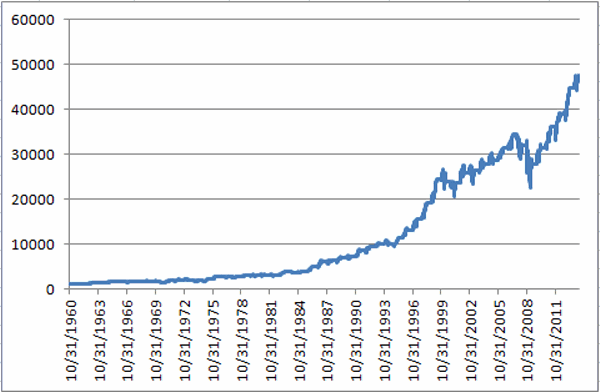
Figure 1 – $1,000 in the Dow from October 31st through 3rd trading day of May (1960-present)
Figure 2 – $1,000 in the Dow from 3rd trading day of May to October 31st (1960-present)
Starting on 10/31/60:
* $1,000 invested in the Dow Industrials each year at the close of trading on the last trading day of October and held through the close of the third trading day of May grew to $47,280.
* $1,000 invested in the Dow Industrials each year at the close of trading on the third trading day of May and held through the close of the last trading day of October decreased to $599.
So to put it in blunt terms:
October to May = +4,628%
May to October = (-40%)
So clearly there is something to the “Sell in May” thing. There is a caveat, however. As you can see from a perusal of Figure 2 it is not as though the stock market declines each and every year during the May to October period. So during many years selling in May and getting back in at the end of October would cause your returns to trail that of the overall market (and we can’t have that now can we?).
So that explains why roughly half of the bazillion annual “Sell in May” related articles warn against blindly selling in May.
What You Probably Don’t Know
Like they always say, sometimes it’s not what you know but who you know that counts. Or in this case, not even someone I have personally met but do associate with. Rob Hanna is the head of Hannah Capital Management (www.QuantifiableEdges.com) and is a colleague of mine in AAPTA (American Association of Professional Technical Analysts). Rob revealed in some of his work the following “guide” for determining whether to “sell in May” or not:
-If the S&P 500 experiences a drawdown of 5% or more between December 31st and April 30th, then sell in May.
-If the S&P 500 DOES NOT experience a drawdown of 5% or more between December 31st and April 30th, then DO NOT sell in May.
Doesn’t get much simpler than that. Since 1960 there have been 14 years during which the S&P 500 did not experience a 5% drawdown and an investor would have simply remained in the market. The results appear in Figures 3 and 4.
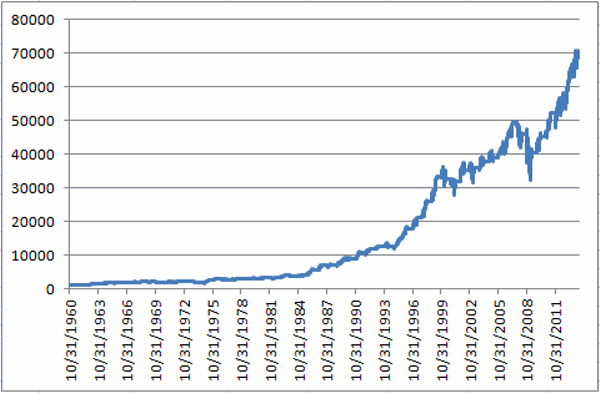
Figure 3 – $1,000 in the Dow during bullish periods applying Hanna Sell in May Filter (1960-present)
Figure 4 – $1,000 in the Dow during bearish periods applying Hanna Sell in May Filter (1960-present)
In cold hard numbers:
* $1,000 invested in the Dow Industrials each year durung the “bullish” periods described grew to $70,244.
* $1,000 invested in the Dow Industrials each year duirng the “beairsh” periods describeed decreased to $403.
So to put it in blunt terms, applying Rob Hanna’s Sell in May Filter:
*October to May (plus May to October when no Sell in May IS NOT triggered) = +6,924%
*May to October (only during years when Sell in May IS triggered) = (-59.7%)
Here’s The Bad News
As you can see in Figure 5, the S&P 500 experienced a drawdown of -5.76% between the end of December and the end of April. And -5.76% is greater than -5% (OK, mathematically speaking -5.76 is technically LESS than 5%, but you get my drift – there was a drawdown in excess of 5%).
Figure 5 – S&P 500 for 2014
So by that rule, the Sell in May model that I prefer says to sell at the close on the third trading day of May and to buy back in at the end of October (although for the record, buying at the end of September is typically better in a mid-term election year, but that’s a topic for another article).
Summary
So because the S&P 500 experienced a -5.76% drawdown is the stock market absolutely, positively doomed to decline between May and the end of October? Of course not. But the historical odds seem to suggest that caution may be in order.
Jay Kaeppel Chief Market Analyst at JayOnTheMarkets.com and AIQ TradingExpert Pro (http://www.aiq.com) client
Jay has published four books on futures, option and stock trading. He was Head Trader for a CTA from 1995 through 2003. As a computer programmer, he co-developed trading software that was voted “Best Option Trading System” six consecutive years by readers of Technical Analysis of Stocks and Commodities magazine. A featured speaker and instructor at live and on-line trading seminars, he has authored over 30 articles in Technical Analysis of Stocks and Commodities magazine, Active Trader magazine, Futures & Options magazine and on-line at www.Investopedia.com.
Apr 21, 2014 | chart patterns, indicators, Moving averages, trading strategies
OK, first off you have to admit that we are getting a little bit soft, don’t you think? I mean, after marching relentlessly higher to the tune of 34% since the November 2012 low, the Dow pulls back about 4.3%. And from all of the racket you would think that the end of the freaking world is apparently just around the corner. We used to be made of sterner stuff. Or so it seemed.
So there is a part of me that wants to shout “Buck up, people”. As a TFF (“Trend Followin’ Fool”) from way back, I would like to think that given the fact that the major stock market averages are above their respective long-term moving averages, we should stop all of the hand wringing and simply acknowledge that (at least for now) the major trend of the stock market is still bullish.
And when I say “I would like to”, I mean I really would “like to”. But the truth is there are a lot of good reasons to be keeping a close eye on the exits. To wit:
Indexes vs. Moving Averages
There is nothing magical about the relationship between the price of an asset/stock/index and its 200-day moving average. That being said, I sure do rely on it a lot – maybe because the interpretation is pretty darn simple:
Price > 200-day moving average = GOOD
Price < 200-day moving average = BAD
In Figure 1 we see four major stock market indexes (the Dow, the Nasdaq 100, the S&P 500 and the Russell 2000 clockwise from upper left).
Figure 1 – Major stock indexes versus their 200-day moving averages (Courtesy: AIQ TradingExpert)
The thing to note is that with the exception of the Russell 2000 – which is only slightly above it’s MA – they are still well above their respective 200-day moving averages. Now granted this could change quickly if prices keep heading south. But the point is that for now, an objective trend-follower still has to designate the major trend as “up.”
Alright, I hope you enjoyed the “Good News”
Is Elliott Wave Waving “Goodbye” (to the Bull)?
Figure 2 displays the Elliott Wave count for the Dow and the Nasdaq 100 as calculated mechanically by ProfitSource by HUBB.
Figure 2 – Dow and Nasdaq completing Elliott Wave 5? (Source: ProfitSource by HUBB)
OK, a few things. For the uninitiated, the Elliott Wave Theory is based on work by – who else, a guy named Elliott – that suggests that price moves up in 5 waves – 3 waves up, 2 waves down – and then declines in 5 waves – 3 waves down and 2 waves up. Now the truth is that a lot of Elliott Wave counts don’t pan out. But I known a lot of people who’s market opinion I respect who follow “the Wave”.
As you can see in Figure 2 both the Dow and the Nasdaq 100 appear to have formed or are in the process of forming a completed 5-wave “up” pattern. The implication going forward is for lower prices ahead.
Sell In May – with MACD Filter (SMMF)
The “Sell in May” pattern was first reported by Yale Hirsch and since then The Hirsch Organization’s Stock Trader’s Almanac has kept track of an updated – and improved version – that uses the MACD indicator to determine the exact entry and exit dates.
By my calculations, this SMMF method issued an early “sell” signal on 4/7/14 as shown in Figure 3. This sell signal remains in effect until at least the end of September (which is significant, as we will see shortly).
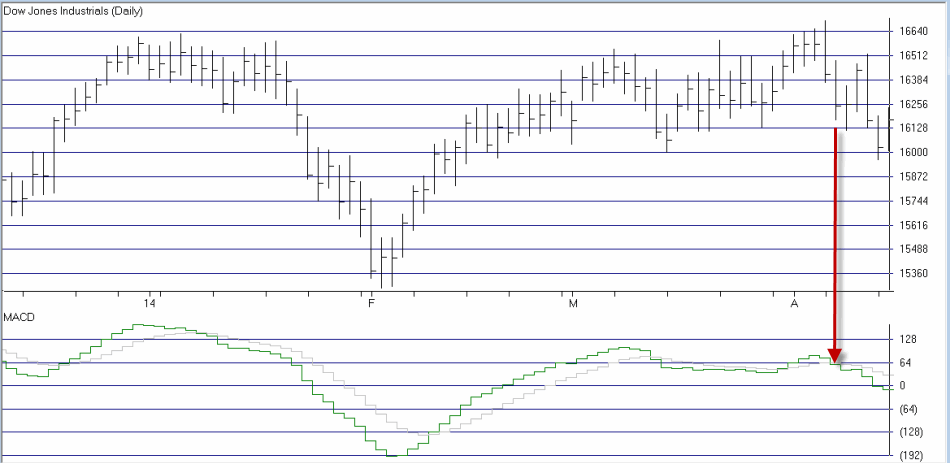
Figure 3 – Early “Sell in May” signal on 4/7/14 as MACD Oscillator turns negative (Courtesy: AIQ TradingExpert)
Why does this SMMF signal matter? In Figures 4 and 5 you can see the growth of $1,000 during bullish and bearish periods as signaled by the “Sell in May with MACD Filter” Method since 12/31/1949.
Figure 4 – Growth of $1,000 invested in Dow Industrial when SMMF Method is bullish
Figure 5 – Growth of $1,000 invested in Dow Industrial when SMMF Method is bearish
Notice any difference? For the record – and excluding any interest earned while of the market:
Bullish Phase gain = +24,753%
Bearish Phase loss = (-68%)
This method is now deemed”bearish.” ‘Nuff said.
Mid-Term Election Time of Year
Let me sum up the historical trend for mid-term election years as succinctly as possible by stating:
“Everything until September 30th is a crapshoot, but ignore any bad news after that.”
This summary is nicely illustrated in Figure 6.
*The blue line in Figure 6 displays the growth of $1,000 invested in the Dow between December 31st of the post-election year and September 30th of the mid-term election year.
* The red line in Figure 6 displays the growth of $1,000 invested in the Dow between September 30th of the mid-term year and December 31st of the mid-term year.
Figure 6 – Stock market shows bullish trend September 30 of mid-term election year through December 31st (Red line)
Again, the interpretation is fairly simple:
Jan 1 to Sep 30 – “Whatever”
Oct 1 to Dec 31 – “Bullish (usually)”
Summary
As a dutiful trend follower – and with the major indexes still holding above their long-term moving averages – I am still wearing the “brave face” and hoping that the stock market will continue to move higher. But if weakness persists or accelerates, it would appear that investors might be wise to take some defensive action (hedge, raise cash, go short) and to check back around September 30th of this year.
Sounds like a good time to invoke one of the most useful old adages:
“Hope for the best, prepare for the worst”
Jay Kaeppel Chief Market Analyst at JayOnTheMarkets.com and AIQ TradingExpert Pro (http://www.aiq.com) client
Jay has published four books on futures, option and stock trading. He was Head Trader for a CTA from 1995 through 2003. As a computer programmer, he co-developed trading software that was voted “Best Option Trading System” six consecutive years by readers of Technical Analysis of Stocks and Commodities magazine. A featured speaker and instructor at live and on-line trading seminars, he has authored over 30 articles in Technical Analysis of Stocks and Commodities magazine, Active Trader magazine, Futures & Options magazine and on-line at www.Investopedia.com.









